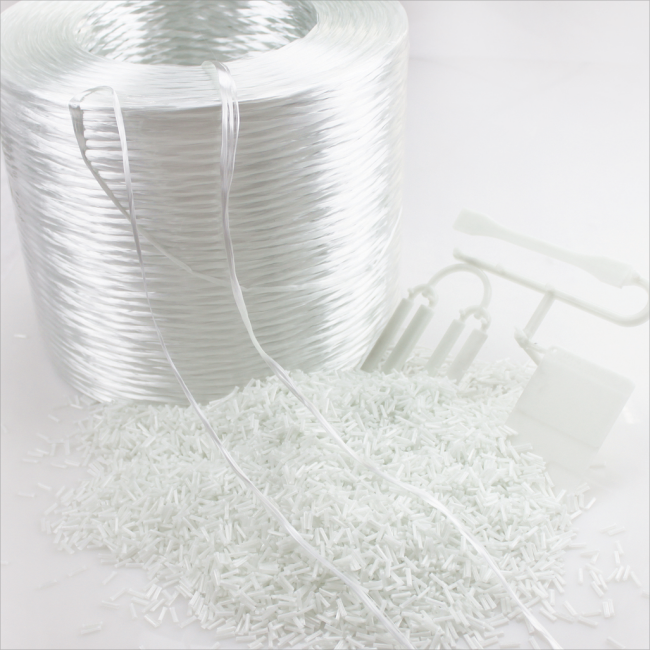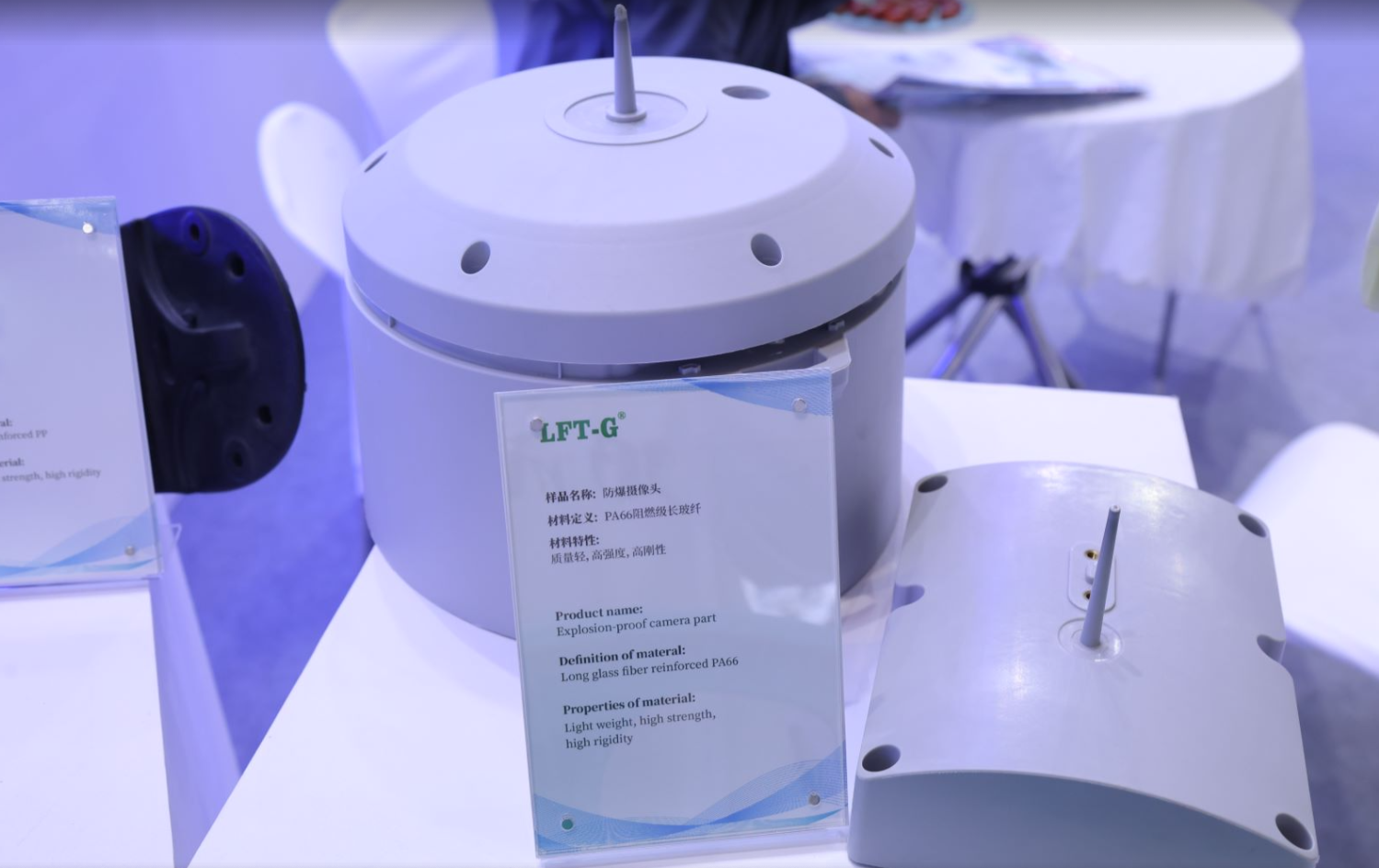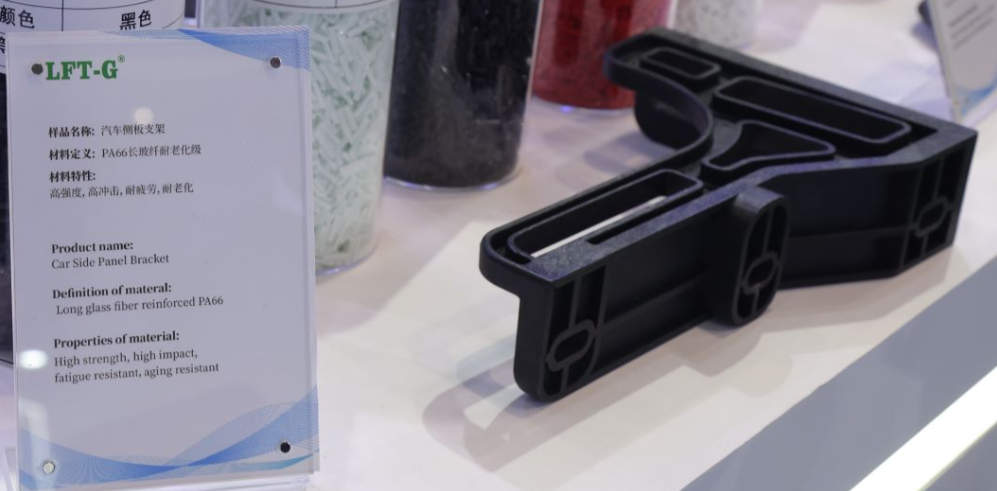Categories
new blog

Polyamide is commonly known as nylon (PA), its main feature is that the polymer main chain contains a large number of amide groups, these amide groups are easy to form hydrogen bonds with each other, and the force between PA molecular chains is strong. Therefore, PA has the characteristics of high crystallinity, high surface hardness, good chemical stability, high tensile and bending strength, wear resistance, heat resistance and so on.
However, there are many defects in PA, among which the main defects are that the temperature and humidity of the external environment have a great influence on the impact strength, dimensional stability and water absorption of PA.
Pure PA materials in many cases can not meet the actual use needs. Therefore, modification usually needs to be considered.
Modification of PA materials by adding inorganic modifiers or blending with other polymers to prepare alloys to meet the high performance requirements of high strength, wear resistance, low temperature resistance, etc.
Compared with organic modifiers, inorganic modifiers have higher strength and thermal stability, making them the main modifiers of PA. The inorganic modifiers for PA modification mainly include inorganic particles such as calcium carbonate and fiber materials such as glass fiber (GF).

GF not only has low cost, but also has high tensile strength, low elongation at break, high elastic modulus, good mechanical properties, heat resistance and dimensional stability, and other properties. Gf is a commonly used polymer modified material with good properties.
There are many studies on the modification of PA by GF. However, there are still great differences in the mechanical and thermal properties of various PA/GF composites reported. This is because the properties of PA/GF composites are affected by many other factors besides the content of PA and GF.
For example, the interface force of GF and PA (GF surface treatment, PA matrix modification), the diameter of GF, the screw combination of the extruder, and the synergistic effect of GF and other inorganic fillers.

Camera part made of LFT-G®️ PA66+GF40
Based on the above factors, the influences of PA/GF composites are reviewed in this paper.
1. The effect of the interfacial force between PA matrix and GF on the properties of PA/GF composites
1) Influence of glass fiber surface modification on the properties of PA/GF composites
Due to the large polarity difference between GF and PA resin, the compatibility between the two is poor, and the interface force between the two is weak. When subjected to external force, the interface disadhesion between GF and PA is easy to occur, which seriously affects the enhancement effect of GF on PA.
Therefore, the surface organic modification of GF is usually carried out to improve the compatibility between GF and PA, the interface force between GF and PA and the dispersion of GF in PA matrix.
Coupling agent is a kind of compound with special structure, which has groups that can interact with inorganic materials such as glass, cement, metal and organic materials such as synthetic resin. It can be used to improve the compatibility between two or more substances and has a wide range of applications.
The coupling agent commonly used for GF surface modification is mainly silane coupling agent, in addition, titanate coupling agent is also used for GF surface modification.
Because titanate coupling agent is easy to hydrolyze in water, a large number of bubbles are generated, and PA material is easy to absorb water, which limits the application of titanate coupling agent to modify GF in PA matrix.
*Sun Peng et al. studied the effect of the concentration of silane coupling agent aminopropyl triethoxysilane (KH550) in aqueous solution and the modification of GF by different silane coupling agents (cyanoethyl triethoxysilane, KH550 and γ-glycidyl ether oxypropyl trimethoxysilane (KH560)) on the properties of PA6/GF composites.
*The results show that the properties of PA6/GF composites modified by 1.5% KH550 aqueous solution are the best. Compared with KH550 and KH560, the properties of PA6/GF composites modified by cyanoethyl triethoxysilane are better.
*However, the tensile, bending and impact properties of PA6/GF composites modified by three silane coupling agents were improved. This is because the surface of untreated GF is smooth, and it is easy to pull out from PA6 matrix. The interface force between modified GF and PA6 matrix is large, and the tensile cross section is interleaved.
In addition, the GF surface modifier commonly used in industry is often a mixture of a variety of substances, called the infiltrator. At present, the common GF infiltrating agent has many components, mainly including film forming agent, coupling agent, lubricant, antistatic agent, etc. Among them, film forming agent determines the quality of the infiltrating agent is very important.
*Li Cuihong et al. synthesized an epoxy resin modified polyurethane film forming agent for modifying GF, and prepared PA66/GF composites. The results show that due to the presence of epoxy group, the modified GF can chemically react with the amide group on PA66 resin, and the interface force between GF and PA resin is significantly increased, which improves the mechanical properties and hydrolysis resistance of PA66/GF composite.
*GF was modified by silane coupling agent and applied to PA composites, but the modification effect was poor. Therefore, in recent years, researchers have modified GF by synthesizing new silane coupling agents or using other surface modifiers, and applied them to PA matrix to further improve the interface force between GF and PA.
*Liu Yuku et al. synthesized a new silane coupling agent (N1-A) using cyanoethyl trichlorosilane and acetic anhydride, and used it to modify the surface of GF.
*Different from the study of Sun Peng et al., compared with the KH550 modified PA composite, when the new coupling agent N1-A is only 0.5% of the surface modifier treatment solution, the tensile strength, bending strength and bending modulus of the modified PA6/GF composite are significantly higher.
*This is because N1-A is hydrolyzed to acetic acid, and under the condition of acid catalysis, amide groups and carboxylic acid groups are further formed, and the generated amide groups form hydrogen bonds with PA6 matrix, while carboxylic acid groups can chemically react with amide bonds in PA6 matrix, improving the interface force between PA matrix and GF.
In fact, in the process of using silane coupling agent, volatile small molecule compounds such as methanol and ethanol are generated, resulting in certain environmental hazards.
*Based on the bionic principle of mussel adhesion, Luo Kaiqiang et al. successfully coated dopamine on the surface of GF by oxidation/self-polymerization method. Due to the presence of many polar groups on the surface of dopamine, strong hydrogen bond interaction was formed between GF and PA matrix, and a strong interfacial force was formed between GF and PA.
*The experimental results show that the enhancement effect of GF on PA6 is better than that of GF modified by KH550, and the method is green and economical, and the preparation process is simple.
In summary, the main purpose of coupling agents or other surface modifiers is to improve the interfacial force between GF and PA matrix. The mechanical properties and hydrolysis resistance of PA/GF composites are greatly improved by increasing the interfacial force between GF and PA matrix.

Car part made of LFT®️ PA66+GF
2) Effect of nylon matrix modification on the properties of PA/GF composites
In addition to surface modification of GF, the PA matrix can be further modified by increasing the PA/GF interface force. The modification of PA matrix mainly includes adding compatibilizers or other modifiers to PA matrix. These modifiers can enhance the interaction force between PA matrix and GF and improve the mechanical properties of PA/GF composites.
*Zhou Lihua et al. added maleic anhydride grafted ethylene-octene copolymer (POE-g-MAH) into PA6T/GF composites as a capacitation-toughening agent. The results show that when the content of POE-g-MAH is 5%, the tensile strength of PA6T/GF composites is increased by about 20%, and the bending strength is increased by 10%.
This is because the acid anhydride on the POE-g-MAH chain can chemically react with the amide group on the PA66 molecular chain, and can also react with the hydroxyl group on the surface of GF, increasing the interface force between GF and PA66.
The surface of GF in PA6T/GF/POE-g-MAH composite with strong interfacial force is rough, which indicates that the bonding between GF and PA resin is good. GF surface is smooth and easy to pull out in the composite section with poor interfacial force.
In summary, compatibilizers improve the mechanical properties of composites by increasing the interaction force between GF and PA.
In addition to compatibilizers, some flow modifiers can also improve the interfacial forces between PA matrix and GF.
*Dohyun et al. prepared three flow modifiers HMDA, DMDA and MCHA using hexanediamine, dodecamethylene diamine, 4,4 '-methylene bis (cyclohexanamide) and fatty acids, respectively, for modifying PA66/GF composites.
*The addition of flow modifier not only improves the fluidity of PA66/GF composites, but also produces hydrogen bond with both PA66 and GF due to the presence of amide bond in the main chain of the flow modifier, which increases the interfacial force between GF and PA66 matrix and improves the dispersion of GF in PA66 matrix. The tensile strength and bending modulus of PA66/GF composites are improved.
In summary, the interaction force between GF and PA matrix can be improved by modifying both GF surface and PA matrix, thereby improving the dispersion of GF in PA matrix and improving the mechanical properties of PA/GF composites.
2. The influence of GF diameter on the properties of PA/GF composites
In addition to the interfacial force between PA matrix and GF, the properties of GF are also an important factor determining the properties of PA/GF composites. For example, the diameter of GF, such as size, strength, modulus and other mechanical properties. At present, the difference between the strength and modulus of GF in the market is small, and the diameter of GF is large. It has been shown that the diameter of GF has a great influence on the properties of PA/GF composites.
*The contact areas between GF and PA66 resin with different diameters (15, 13, 11 and 10μm) were theoretically calculated by Zhijian Zhang et al. The results show that the ratio of contact area between GF and PA66 matrix resin is 1:1.1 ∶1.3∶1.5.
*The experimental results show that the tensile strength and impact strength of PA66/GF composites increase with the increase of the contact area between GF and matrix. This is because the larger the contact area between GF and PA resin, the greater the interfacial force between them. Moreover, with the increase of GF diameter, GF surface becomes smoother and the "hinge degree" with the resin decreases.
*Tang Youqian et al. studied the performance differences of PA6/30%GF composites with different diameters GF, and the results are shown in Table 1. As can be seen from Table 1, the smaller the diameter of GF, the higher the tensile strength, bending strength, bending modulus and impact strength of the material, and the higher the melt flow rate. However, when the diameter of GF is less than 10μm, its price is greatly increased, the cost performance is low, and the actual use value is low.
3. The influence of screw combination on the performance of PA/GF composites
In addition to the above PA/GF composite components, the processing technology is also one of the factors determining the performance of PA/GF composites. Among them, the screw combination for preparing PA/GF composite extruder is the most influential.
This is because the screw combination largely determines the length and dispersion of GF in the PA matrix. The results show that when the length of GF in PA matrix ranges from 300 to 400μm, the strengthening and toughening effect of GF on PA matrix is better, and the strengthening and toughening effect of too long or too short GF on PA matrix is poor.
This is because too short GF is difficult to penetrate the matrix, and too long GF is difficult to disperse evenly in the PA matrix. According to the action of the screw, the shear force of the screw has a great influence on the length of GF. The screw combination of GF reinforced polymer consists of a feeding section, a melting section, a second feeding section, a mixing section and an exhaust section, in which the length of GF is mainly affected by the mixing section.
In order to obtain the appropriate length of GF and its good dispersion in PA matrix, the shear capacity of screw can be adjusted by increasing or reducing the number of mesh blocks and adjusting the position of mesh blocks in the screw. The specific screw combination method should be determined according to extruder model number, screw length-diameter ratio and other factors.
In addition to meshing blocks, specially shaped threaded elements, such as tooth plates and reverse tooth plates, are effective in the preparation of PA/GF composites. The gear disc element can improve the dispersion of GF and reduce its wear on GF.
Among them, due to the opening of the spiral edge of the SME tooth disk element, its conveying capacity and decompression capacity are reduced, and the filling degree of the material in the spiral groove is increased, which extends the residence time of the material. Therefore, the tooth plate element is used in the screw combination, and the tensile strength, bending strength and impact strength of PA66/GF composite are significantly improved.
*Chen Baiquan et al. designed three screw combinations for the mixing section of the extruder to prepare PA6 composites with high GF filling.
The results show that by using 1 set of thick meshing blocks and 1 set of SME tooth mixture elements, and adding 2 sets of thin meshing block screw combination, combined with the second side feed adding GF, the dispersion uniformity of GF in the prepared PA6/GF composite material is better, and the length is between 300 ~ 500μm. The mechanical properties of PA6/GF composites are greatly improved.
*Jiang Zhaoyin et al. applied the reverse tooth plate to the preparation of PA66/GF composite screw, and designed a variety of screw combinations.
The research shows that compared with the meshing block, the reverse tooth plate can not only mix PA66 and GF evenly, improve the conveying efficiency, but also properly reduce the shear strength of the screw, reduce the wear degree of GF under molten shear, ensure the length and integrity of GF, reduce the defects of PA66/GF composite material, and improve the mechanical properties of the composite material.
The above research status shows that the PA/GF composites with better performance can be obtained by using the screw combination of meshing block, tooth plate and reverse tooth plate elements. At the same time, the screw combination is closely related to the feed position of GF, and the relative positions of the meshing block, tooth plate and reverse tooth plate elements need to be adjusted according to the feed mode of GF to achieve the best screw shear.
4. The effect of the synergistic effect of GF and other inorganic fillers on the properties of PA composites
GF plays an obvious role in enhancing the mechanical properties of PA, but it also makes PA matrix brittle and the sample apparent bad.
Inorganic nanoparticles have a large specific surface area and many active sites on the surface, and can be modified by various types of surfactants to improve their compatibility with PA materials. For example, the modified inorganic nanoparticles can chemically react with the amide groups of PA materials to produce a good interfacial force, which is much greater than the van der Waals force.
At the same time, inorganic fillers have various shapes, such as granular, flake, fibrous, etc., and different shapes of inorganic fillers have different modification effects. Therefore, the inorganic fillers can improve the performance defects of PA/GF composites, and the synergistic modification of PA by inorganic fillers and GF can further improve the performance of PA/GF composites.
In PA/GF composites, flake inorganic fillers, including talc powder and montmorillonite, are widely used.
*Yang Zhen et al. studied the effect of the ratio of talc and GF on the mechanical properties of PA66 composite.
*The results show that compared with pure PA66, PA66/30% talc powder and PA66/30%GF, the tensile, bending and impact strength of the composites are significantly improved when the mass ratio of PA66/ Talc /GF is 70/5/25.
This is due to the fact that talc and GF are uniformly dispersed in PA66 matrix. When the material is subjected to stress, the stress concentration of talc particles leads to the deformation of PA matrix and the formation of silver lines, which absorbs a large amount of deformation work.
Moreover, the multi-axial orientation of GF along the lamellar talc makes GF "skeleton" able to bear greater stress. GF and talc give full play to their respective advantages. Therefore, the synergistic enhancement effect of GF and inorganic filler on PA matrix can be realized by adding them appropriately. This phenomenon has also been verified in the study of preparing PA6/GF/ talc foamed composite materials by Shen Chao et al.
At the same time, talc has a lubricating effect, can reduce the floating fiber phenomenon of composite materials, and inhibit the warping deformation of injection samples. When the mass ratio of PA66/GF/ talc is 70/10/20, the apparent properties of the composite are significantly improved.
*In addition, Hu Jin et al. used organic montmorillonite (OMMT) to co-modify PA66 with GF. The results show that when the mass ratio of PA66/GF/MMT is 100/25/7, the tensile strength, bending strength and impact strength of PA66/GF/OMMT composites reach the maximum value, which is better than that of PA66 composites with the addition of GF or OMMT alone.
*This is due to the fact that the OMMT layer is stripped and evenly dispersed in the PA66 matrix, and OMMT acts as a nucleating agent in the PA66 matrix, which improves the crystallinity of PA66 and thus improves the strength of the composite.
In addition to flaky inorganic fillers, some studies have used acicular inorganic fillers and GF to co-modify PA.
*Ma and his colleagues prepared PA6/GF/ wollastonite composites by melt blending, which improved the tensile strength and bending strength of the composites, and also improved the surface properties of GF reinforced PA6.
*GF can significantly enhance PA6, while wollastonite can reduce the shrinkage of the composite. When the total amount of wollastonite and GF is 30%(the mass ratio of wollastonite to GF is 1∶2), the mechanical properties and surface properties of the material are better.
All the above studies show that the PA/GF composite can be modified with flake or acicular inorganic fillers and GF, which can give better mechanical and apparent properties of PA/GF composites. Therefore, the synergistic modification of PA by inorganic fillers and GF has become an important research direction for PA/GF composites.
5. Conclusion
In summary, the existing literature shows that the interface force between GF and PA can be improved by GF surface modification and PA matrix modification, the dispersion of GF in PA matrix can be improved, and the mechanical properties and hydrolysis resistance of PA/GF composites can be improved. The smaller the diameter of GF, the better the mechanical properties of PA/GF composites, but the smaller the diameter of GF is higher.
The mechanical properties of PA/GF composites can be significantly improved by the rational use of tooth shaped disc or reverse tooth shaped disc and meshing block. The mechanical properties of PA composite modified by other inorganic fillers and GF are better than those modified by GF alone. In addition, other inorganic fillers can improve the floating fiber phenomenon of GF in PA matrix and obtain more excellent apparent properties.
At present, the main research directions of GF modified PA composites are strengthening, toughening, heat resistance, dimensional stability, etc. In the future, the research directions of GF modified nylon composites are as follows:
(1) Optimize GF surface modifiers, focus on developing new and efficient surface modifiers, further improve the interfacial force between matrix and GF, improve the dispersion of GF in PA matrix, and obtain PA/GF composites with higher mechanical and thermal properties.
(2) Seek better flow AIDS to improve the processing fluidity of PA/GF composites and reduce the degradation of PA matrix during processing.
(3) Optimize the synergistic modification of PA by other inorganic fillers and GF, clarify the synergistic mechanism of GF and inorganic fillers, improve the performance of PA/GF composites, and expand the application range of PA/GF composites.